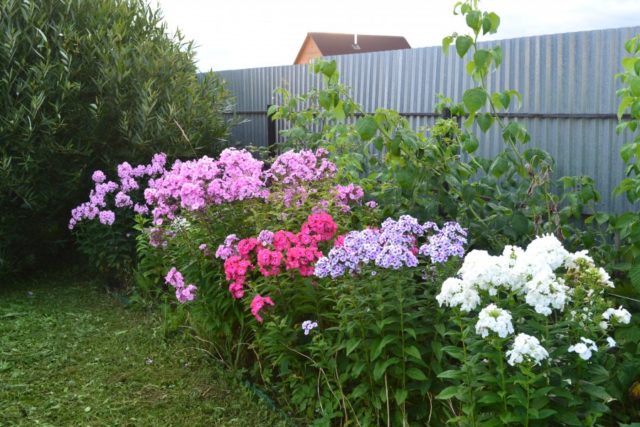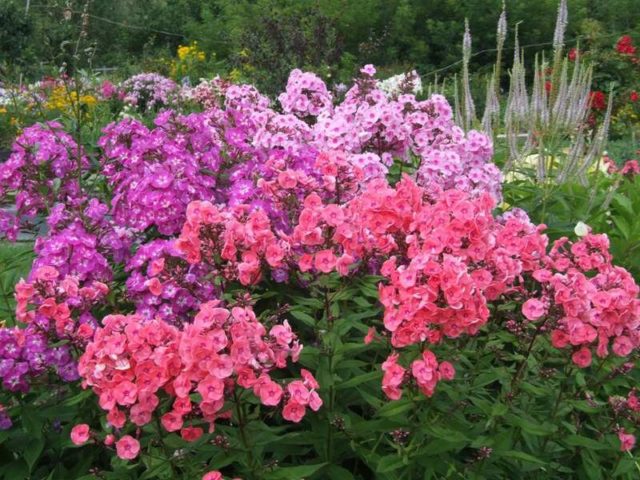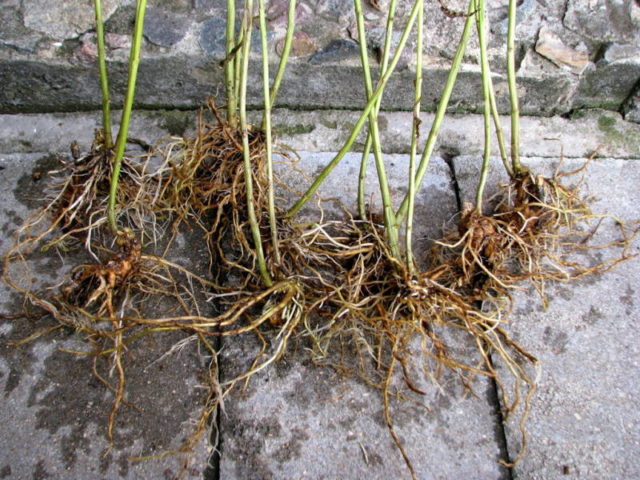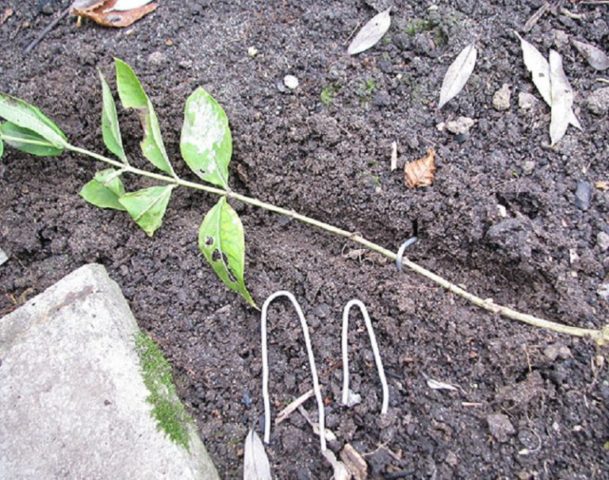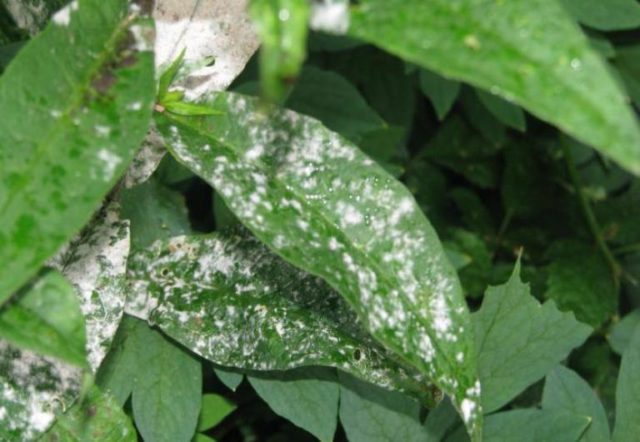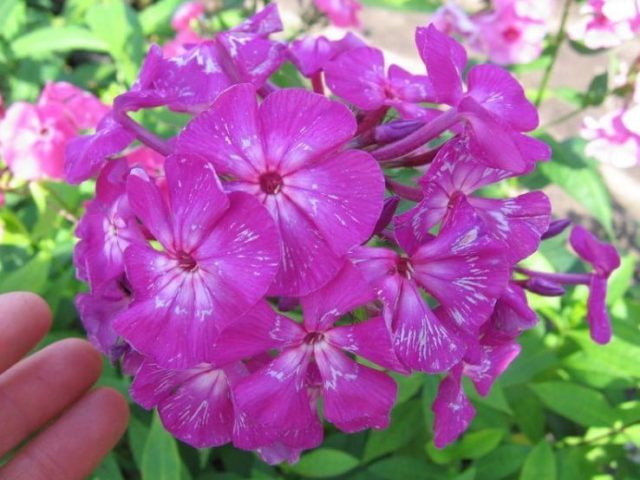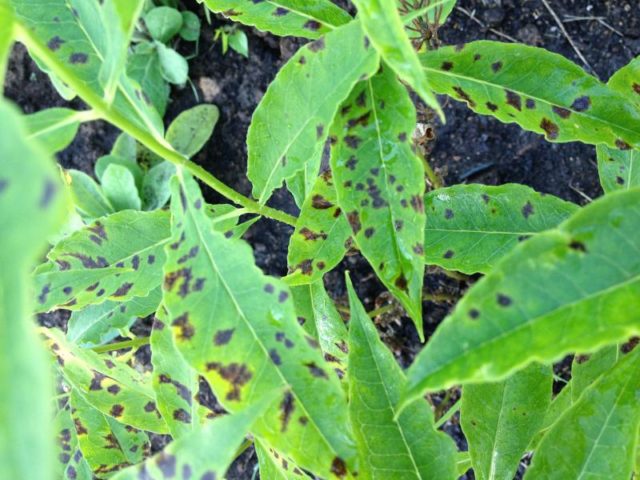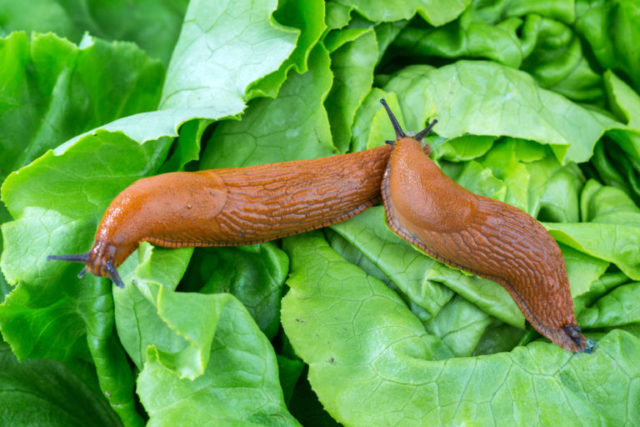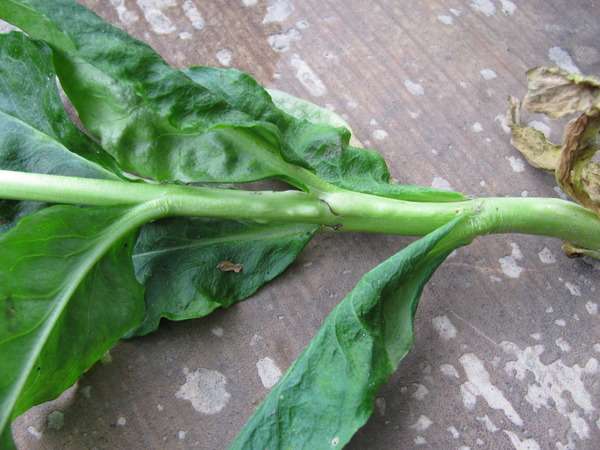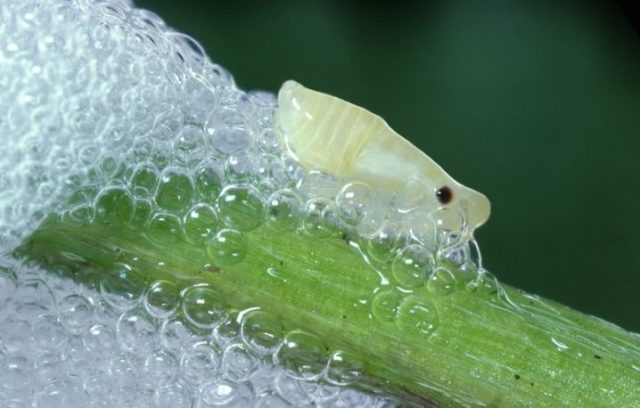Content
- 1 General description of paniculate phlox
- 2 The best varieties of paniculate phlox
- 3 Breeding features of perennial paniculate phlox
- 4 Planting and caring for perennial paniculate phlox
- 5 Pests and diseases
- 6 Conclusion
Phlox paniculata is an ornamental perennial plant, represented by numerous varieties. It is interesting to get acquainted with the popular varieties and find out the rules for caring for them.
General description of paniculate phlox
Panicled phlox is a herbaceous perennial, usually a medium-sized bush with paniculate inflorescences in the upper part. The stems of the plant are fragile, but rather strong; by the end of summer they begin to woody.

Panicled phlox is quite strong and rarely needs support
The leaves of the paniculate phlox are elongated, lanceolate, paired, growing crosswise on the stem. The plant blooms with small five-petal flowers, collected in inflorescences, at the end of flowering it bears fruits - small boxes with seeds.
The size of the bush and the height of paniculate phlox
The plant can rise to a height of 60-180 cm above the ground. In width, the bushes spread on average up to 150 cm, grow rapidly.
How and when paniculate phlox bloom
Paniculate phlox blooms in mid-summer, around mid-July. This period is considered early, late varieties bloom only in August.
Flowering continues for 1-2 months, throughout the entire time the plant looks very decorative. The flowers, small in themselves, form into large inflorescences of a spherical, conical or cylindrical type, up to 30 cm in diameter. Despite the fact that each of the small buds lives for a little more than a week, flowering does not occur simultaneously, and this allows the bushes to remain lush and beautiful for a long time.
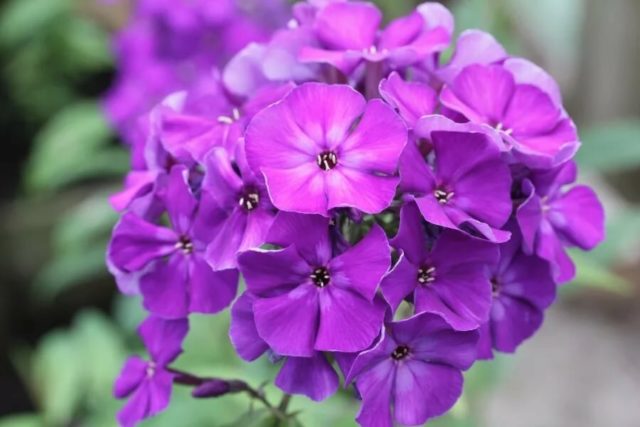
Small flowers of the plant are collected in large inflorescences
Panicled phlox in landscape design
Unpretentious, but very beautiful paniculate phlox are widely used in landscaping. Most often they are planted:
- along the high hedge, lush shrubs enliven the landscape and hide a bare plain fence;
Flowering bushes decorate fences and hedges well
- alone in unoccupied corners of the garden, a flowering perennial is a very noticeable plant in the garden and attracts attention;
Phlox of different colors can be used to form a spectacular flower bed
- as part of art groups, paniculate phlox often acts as a background for astilbes and other flowering perennials, and it is also planted next to tall shrubs and conifers.
The plant goes well with other shrubs and flowers
Perennial feels comfortable in light, but slightly shaded areas and on moist soil. Therefore, you can plant it near a reservoir, decorating the shores with shrubs, or in a garden area where other bushes and plants grow poorly due to a light shade.
The best varieties of paniculate phlox
There are a lot of varieties of paniculate phlox. But of them, the most popular varieties can be distinguished, which are found most often in summer cottages.
New varieties of paniculate phlox
Breeding of new varieties is ongoing. Over the past few years, European hybridizers have delighted fans of ornamental shrubs with several new products.
Blue Paradise
Reaches 1.2 m in height and grows up to 60 cm in diameter. The plant blooms in medium terms, from the second half of July to autumn. Blue Paradise brings spherical or conical inflorescences, blossoming buds have a deep blue color, after full disclosure they turn blue-violet. Phlox flowers are quite large, up to 4 cm in diameter.
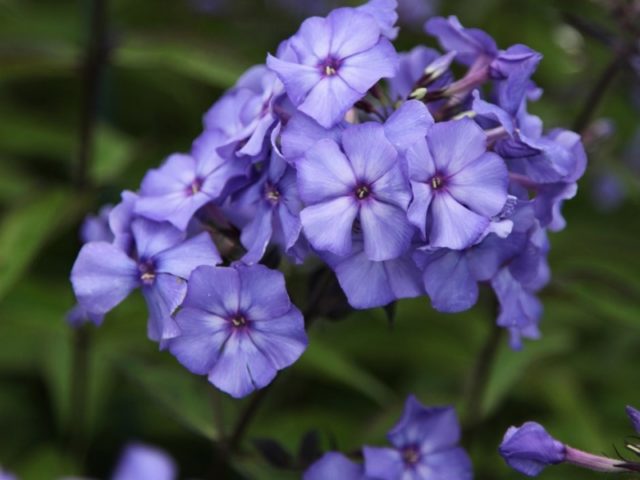
Blue Parades is a popular blue variety
Hesperis
Another new variety of Dutch selection is the paniculate phlox Hesperis, reaching 1.4 m in height. An upright bush gives large branched inflorescences slightly resembling lilac twigs. In shade, the flowers of the variety are dense lilac, with a uniform color, and they appear on the branches in mid-August, bloom for about 45 days.
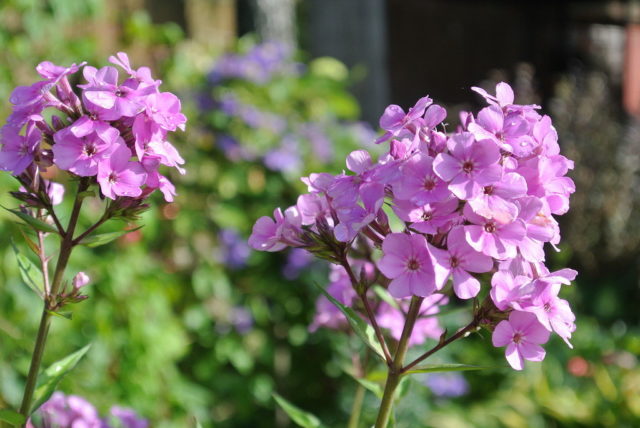
Hesperis - a cultivar with August flowering
The Queen of Spades
A novelty of Russian selection is the Pikovaya Dama variety with an average flowering in mid-July. Brings purple-lilac flowers with a crimson eye, in cloudy weather it acquires a bluish-purple hue. The bush reaches 90 m in height, and the diameter of individual flowers is about 4 cm. The inflorescences of the Queen of Spades are conical in shape, dense.
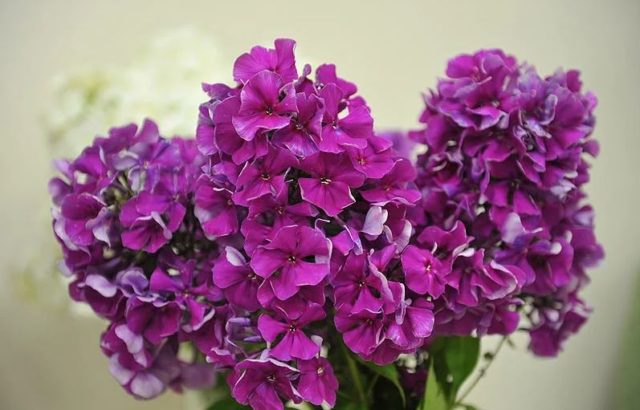
The Queen of Spades is one of the newest varieties
Early varieties of paniculate phlox
The earliest varieties are those that bloom in mid or late June. Such phloxes look very good in lush flower beds and group compositions in the garden, if they bloom simultaneously with neighboring plants in the midst of summer.
Fog
It reaches 80 cm in height, has good spreading and blooms very profusely. Flowering usually begins in mid-June and lasts about 1.5 months. Paniculate phlox brings dense rounded-conical inflorescences, consisting of delicate lilac flowers with a bright crimson eye in the middle. In the morning and evening, the inflorescences appear bluish.
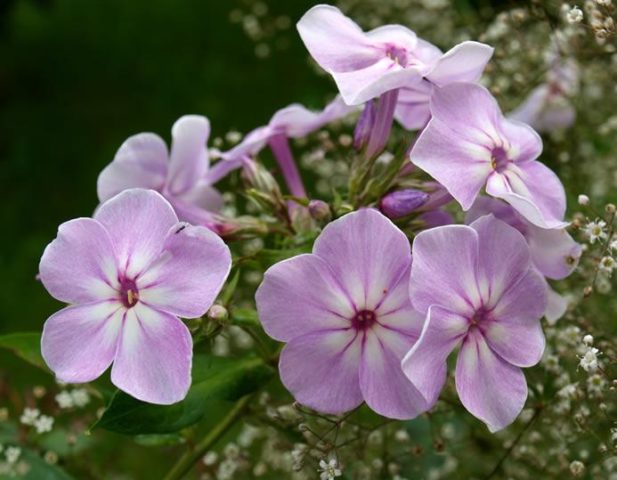
The fog changes color depending on the lighting
Apple Blossom
A low panicled phlox rises up to 65 cm above the ground, is compact in size, grows rapidly. Brings dense inflorescences-umbrellas of a soft pink warm color, closer to the middle, the flowers are whitish, and in the center they have a dark pink eye.
The variety blooms with good care in mid-June. Individual flowers are quite large - up to 4.5 cm wide.
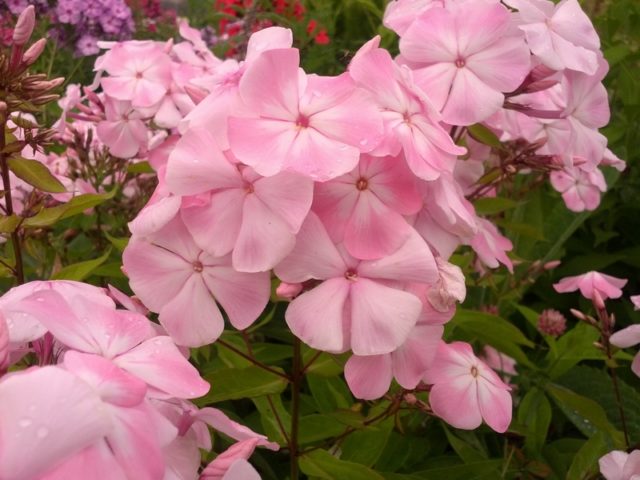
Apple Blossom is distinguished by a very delicate and bright flowering.
Storm
The height of the paniculate phlox is about 1 m, flowering occurs in late June or early July. The plant bears lilac-purple flowers with a smooth transition of shade and a crimson eye in the center. Inflorescences are round, slightly loose in shape.
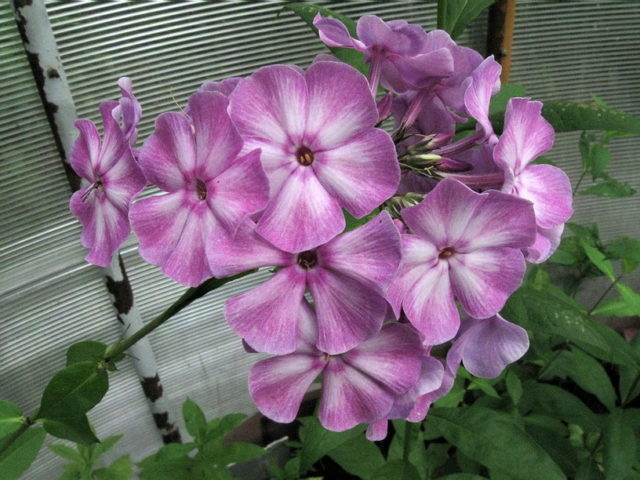
Thunderstorm - lilac variety for shaded areas
Varieties of paniculate phlox with large flowers
Almost all paniculate phloxes produce large and prominent inflorescences. But the most decorative are varieties with large-diameter flowers, they are collected in especially wide clusters of a spherical or conical shape.
Miss Kelly
Tall paniculate phlox rises to 1.1 m, brings white-purple flowers with a light eye in the center.Individual flowers reach 4.5 cm in diameter, due to which the inflorescence grows up to 20-25 cm wide.
The variety blooms in medium terms, usually in mid-July to early autumn.
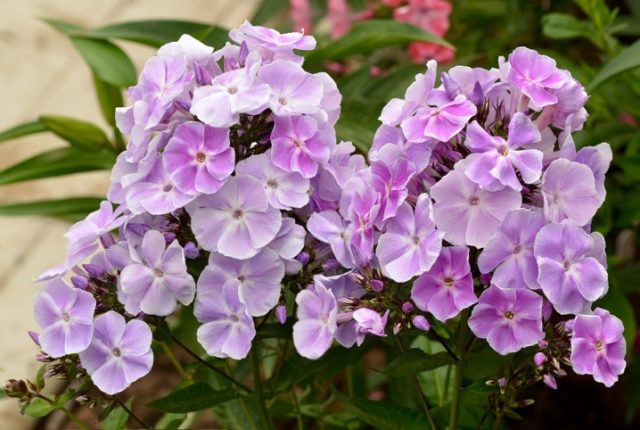
Miss Kelly is a tall, large-flowered variety
Anna German
The well-known variety of paniculate phlox reaches 80 cm, in mid-July it begins to bloom with beautiful salmon-pink flowers with a lighter shade towards the center and a purple ring in the middle. The flowers are up to 4.5 cm in diameter, gather in large and lush rounded-conical inflorescences.
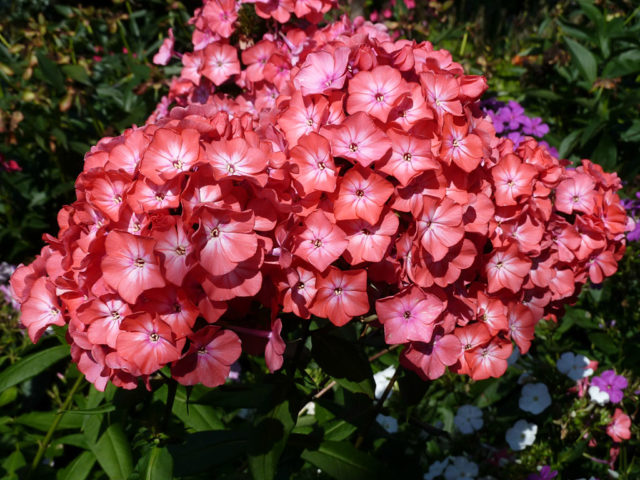
Anna German brings large and very bright flowers
Sandro Botticelli
Popular low-rise variety up to 75 cm, with rapid growth and flowering in mid-July. Brings round-conical dense inflorescences of an even lilac shade, in the evening twilight it seems bluish. The flowers reach 5 cm in diameter, the variety looks very decorative. It grows well in the shade, but in the sun it can fade a little.
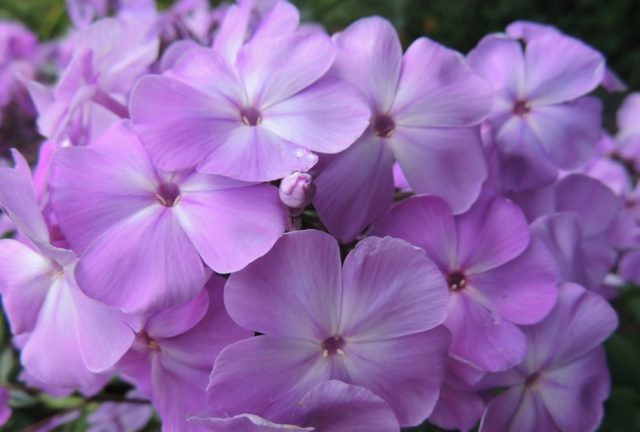
Sandro Botticelli is a large-petal variety.
Varieties of white paniculate phlox
Perennials with white flowers seem rather modest and simple, but are in great demand. In the garden, such a shrub becomes a bright fresh accent, it looks very attractive against the background of dark greenery, it is clearly visible in shady places.
Marshmallow
Low grade Zephyr can reach 70 cm in height. Flowering begins in mid-summer and lasts until early September, phlox inflorescences are pale white, with a pale purple core and indistinct diverging rays of a pinkish hue. The inflorescences themselves are dense, rounded in shape.
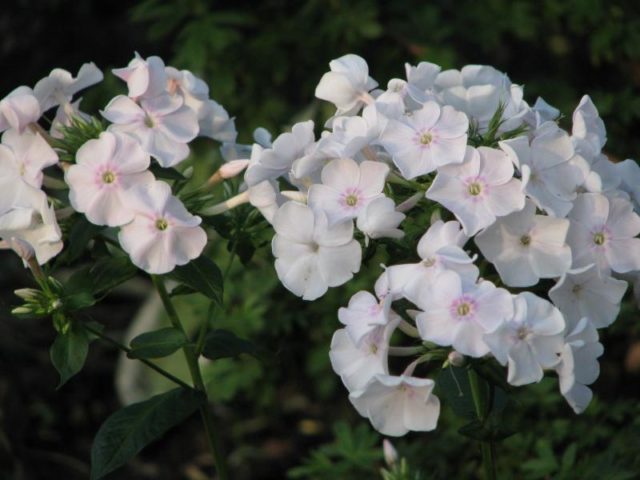
Marshmallow changes shade from white to pinkish, depending on the area
Snow White
The variety brings snow-white flowers with a small yellow eye. Snow White blooms with lush pyramidal inflorescences, reaches 80 cm in height. Flowering occurs from mid-July. Although the stems of the variety are strong, they can droop under the weight of the flowers, so the variety is often tied to supports.
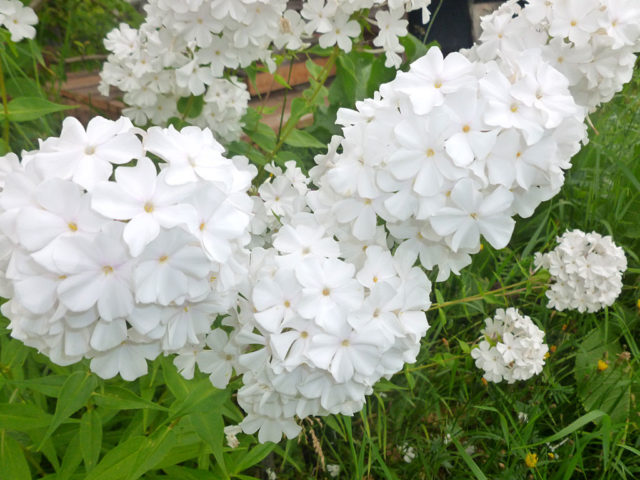
Snow White lives up to its name
The Swan Princess
A medium-sized perennial reaches about 70 cm in height and produces lush, elongated inflorescences in mid-July. The flowers of the variety are quite large, up to 4.5 cm wide, bright white in color, star-shaped in shape. A characteristic feature of the variety is the dense foliage of the shoots and rapid growth.
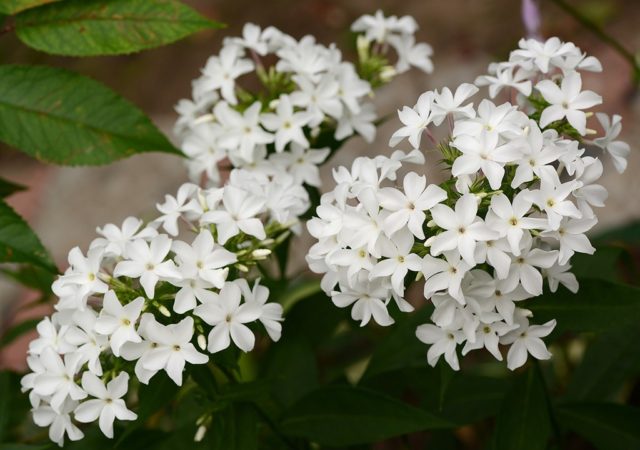
White flowers of the Tsarevna Swan variety have an unusual shape
Varieties of red paniculate phlox
The attention of gardeners is attracted by red phlox, they look very bright and go well with a dark green or lighter background. With the help of red varieties, you can highlight a section of the garden and focus on the artistic group in which the phlox grows.
Margarita
The red variety of paniculate phlox reaches 90 cm in height, blooms from July to early September. The inflorescence variety brings dense, wide, consisting of large flowers up to 4.5 cm. The shade of flowering is deep red with a raspberry tinge, such a phlox is guaranteed to attract attention.
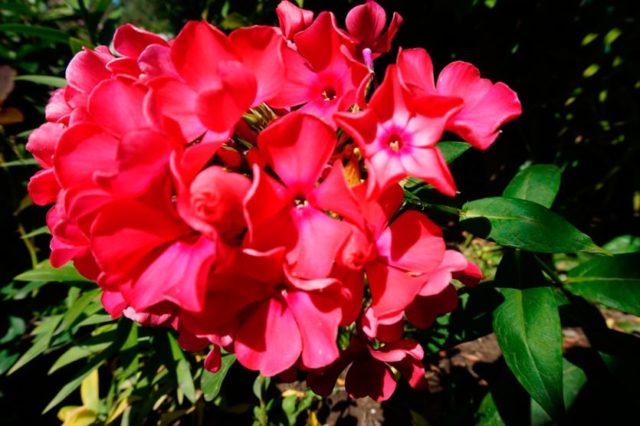
Margarita is a very showy red variety
Miss Mary
The red variety has an average height of 60 to 80 cm. The phlox bloom is average in terms of timing, from mid-July to September, the inflorescences are rich red, with a raspberry tint and a slight transition to purple closer to the core. On the site, Miss Mary creates a vibrant holiday atmosphere.
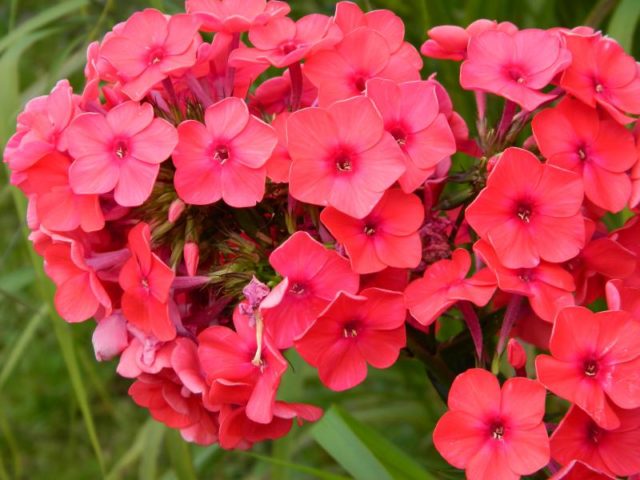
Miss Mary - red phlox with globular inflorescences
Starfire
The decorative paniculate phlox has a very beautiful cherry-red bloom. Dense spherical inflorescences appear on its shoots in July, decorative effect lasts until September. The leaves of the variety are also very beautiful; in spring and early summer, a bronze bloom remains on the juicy green leaf plates.
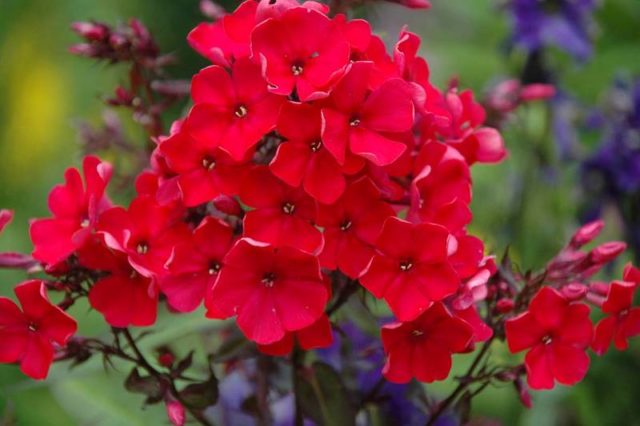
Starfire - bright red look
Original varieties of perennial paniculate phlox
Plants with an unusual color, combining different shades, are of great interest to florists. Most varieties are evenly colored, so two-tone paniculate phlox are always eye-catching and make you see the flowers better.
Sherbet Cocktail
The unusual phlox reaches about 70 cm in height and blooms at the end of June. Flowering lasts until August, the variety brings flowers small, collected in spherical dense inflorescences up to 30 cm in diameter.
An unusual feature of the variety is the presence of a yellow tint in the color of the inflorescences. The unblown buds of paniculate phlox are pure yellow, after blooming, they retain light green edges, and the center of the flowers becomes white-pink.
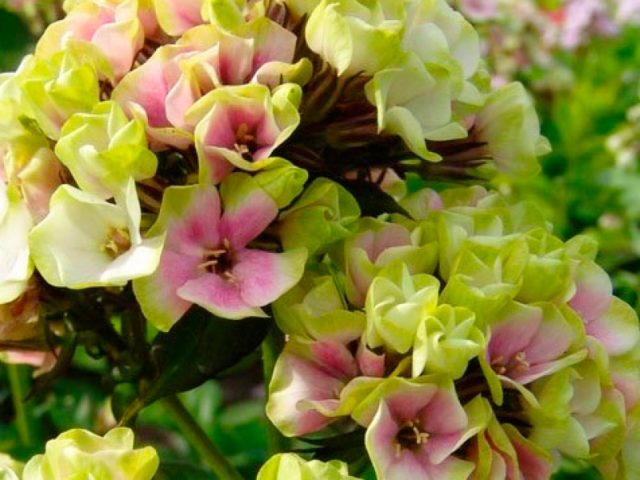
Sherbet Cocktail - a unique species with yellow tints in bloom
Success
The bush grows up to 80 cm and gives large dense inflorescences in mid-July. Basically, the flowers of the paniculate phlox of this variety are purple, but in the center they have a clearly distinguished white star. This gives the bushes an unusual look. The bushes are densely leafy and form well.
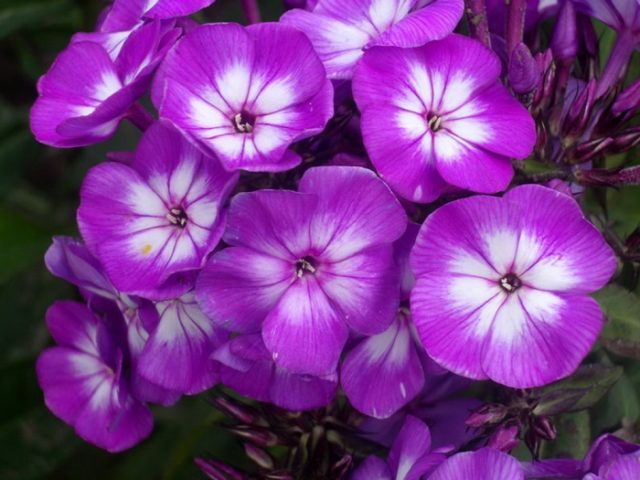
Success is an unusual species with a white eye in the center of a purple flower
Gzhel
Another unusual variety reaches about 1.1 m in height. Brings inflorescences from mid-July and retains maximum decorative effect until mid or late September. Inflorescences in Gzhel are spherical, consist of very interesting two-colored flowers. The petals of the variety are white, but with thick, smoothly distributed blue or purple shadows. In the center of the flower is an ink eye.
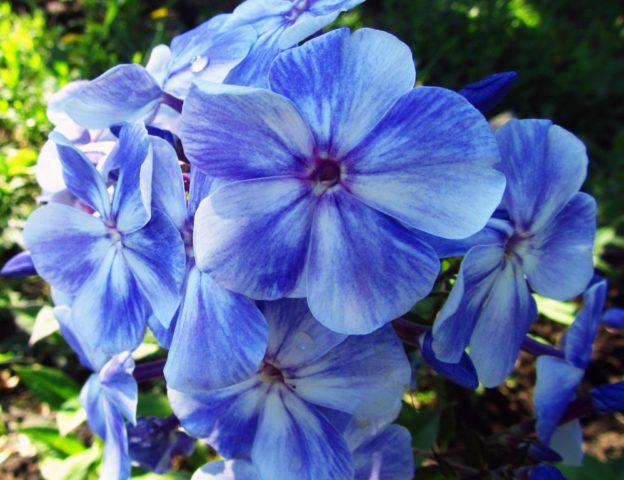
Coloring of flowers Gzhel lives up to its name
Breeding features of perennial paniculate phlox
Paniculate phloxes are propagated by several methods. For adult plants, the following methods are most often used:
- dividing a bush - an adult phlox is dug out after flowering and divided into 3-4 parts, and then immediately transplanted to new places;
Dividing the rhizome is a convenient way to propagate an adult plant
- grafting, in May, strong shoots are cut off at the base of the paniculate phlox, cuttings about 10 cm long are cut, and then planted in a shaded garden bed and await rooting;
The plant reproduces by cuttings worse, but the method is popular
- layering, in the spring, the lower shoot of the plant is bent down and fixed with a slight deepening into the ground, in the fall the cuttings take root.
Layers are a very simple propagation method
The most effective are division and propagation by layering, since paniculate phlox show better survival rate than when propagated by cuttings.
Growing paniculate phlox from seeds
Paniculate phlox is often germinated with seeds, the plant responds well to this method of propagation. For seedlings, both purchased and collected from garden phlox seeds are used:
- First of all, the seeds need to be germinated. To do this, at the beginning of spring, they are slightly buried in wet sand, sprayed abundantly and kept at a temperature of about 20 ° C under a film. After 2-3 weeks, the first seedlings appear from the seeds.
- After that, the germinated material is transplanted into a nutrient soil of peat, sand and humus, mixed in equal proportions, watered and covered with a film. From time to time, the film is removed for ventilation, the soil is regularly moistened.
- After about 2 weeks, the first sprouts of phlox appear. When they get stronger, you will need to dive and then keep the seedlings in a warm place with diffused light.

At home, phlox from seeds is grown until May.
Seedlings are planted in open ground in early May. Pre-phloxes need to be tempered, briefly taken out into fresh air, gradually increasing the duration.
Planting and caring for perennial paniculate phlox
It is not difficult to plant and grow paniculate phlox successfully.It is important to provide light shading and good watering for plants; otherwise, perennials have low growing requirements.
Recommended timing
Both the seedlings bought in the nursery and the matured home seedlings are transferred to the ground in late April or early May. Return frosts have already passed by this moment, the soil has time to warm up well. Plants with early flowering can also be planted in August and early September, but such dates are usually chosen in warm regions.
Site selection and soil preparation
Perennial phlox prefers areas with diffused lighting and light shade in the afternoon. The plant loves moist and nutritious soil. If the soil is poor, then 2 weeks before planting, the site must be dug up and added to the soil with humus, river sand, peat and lime.

You need to plant a perennial in a lighted place with light shading.
A few days before planting phlox, you need to dig a hole about 30 cm deep. At the bottom of the pit, drainage is equipped, then it is half covered with soil with the addition of peat, sand and humus, and complex fertilizers are also applied.
Landing algorithm
After the soil in the hole settles a little, and the top dressing has time to dissolve in the soil, they begin to plant the plant. The seedling is soaked in water for a couple of hours to nourish its roots, and then dipped into a hole and gently straighten the root system.
Sprinkle the roots with soil residues; the root collar does not need to be buried. The seedling is watered abundantly and the soil around the trunk is compacted, the near-trunk circle is mulched with 5 cm of peat.

A shallow hole is needed - the roots of the plant are not too long
Follow-up care
The plant does not react well to drying out of the soil, so it needs to be watered regularly. In the spring, watering is carried out weekly, during the flowering period - once every 2 weeks in the absence of drought. On hot days, perennials are recommended to be sprayed. It is necessary to water the plant, including in the fall, until October, if there is almost no rain.
Panicled bushes are fed several times per season. In early May, you need to add ammonium nitrate, ash and superphosphate under the bushes, at the end of May - mullein infusion. Then the plant is once again fed with ash, saltpeter and superphosphate during the formation of buds, and after flowering, complex fertilizers are applied in granules.
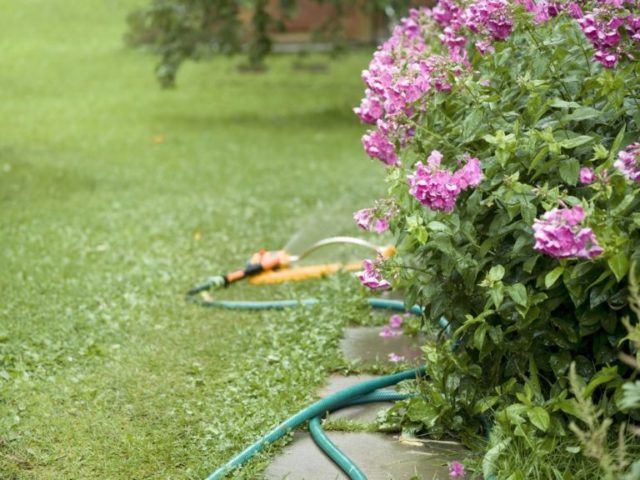
It is extremely important for the plant to provide frequent watering.
Pruning for paniculate phlox is carried out in the spring before flowering. Usually, only 7 of the strongest and healthiest shoots are left, the plant in this case directs all resources to lush flowering and does not spend energy on maintaining excess green mass.
Preparing paniculate phlox for winter
For the winter, paniculate phlox is usually cut off completely, flush with the ground. This is done in late September or early October, with the onset of the first frost, and after the phlox has dropped the foliage.
The cut plant is thoroughly covered with mulching material, for example, peat, and from above it is insulated with spruce branches or straw. In such conditions, the perennial will be able to survive even a very harsh winter and in the spring will give new strong shoots.
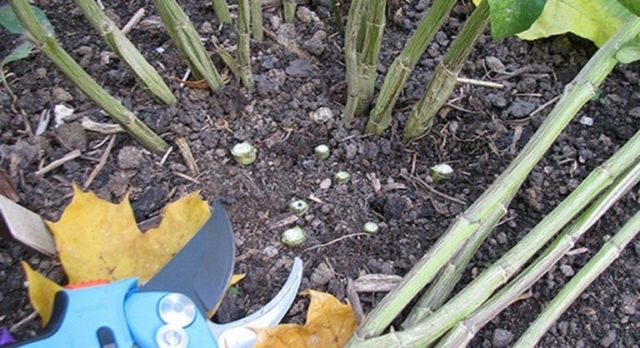
Cut the bushes with the onset of autumn flush with the ground
Pests and diseases
Most often, paniculate phlox suffers from several ailments:
- Powdery mildew. A white mold-like coating appears on the leaves of the plant, the leaves dry out and die off.
Powdery mildew leaves recognizable white spots
- Variegatedness. A viral disease disrupts the color of the petals, the flowers are covered with light irregular stripes, the phlox begins to grow worse.
The variegation virus impairs the decorative effect and interferes with the development of the bush.
- Rust. The fungal disease manifests itself as dark rusty spots and dots on the leaves, leading to wilting.
Rust affects the leaves of paniculate phlox
The fight against fungi is carried out using Bordeaux liquid or fungicides - Topaz and Ridomila Gold.It is important to remove all affected parts of the bush first.
Of the pests for paniculate phlox are dangerous:
- slugs, they feed on the juices of foliage and stems and oppress the plant;
Slugs are harvested by hand or scared away with chemicals
- nematodes, microscopic worms invisibly infect a perennial and lead to its deformation, foliage twisting and wilting;
Fighting nematodes is the most difficult, usually the plant is simply eliminated
- slobbering penny - the pest feeds on foliage and shoots, as a result of which the decorativeness of the plant suffers and growth slows down.
Pennitsa leaves a characteristic foam trail
When infected with nematodes, the diseased plant is recommended to be removed from the site and burned. In other cases, spraying with garlic and soapy water helps well, as well as treatment with insecticidal preparations, for example, Commander.
Conclusion
Phlox paniculata is a beautiful and undemanding plant that can decorate any garden. White, red and multi-colored perennial varieties provide very wide opportunities for landscaping.
